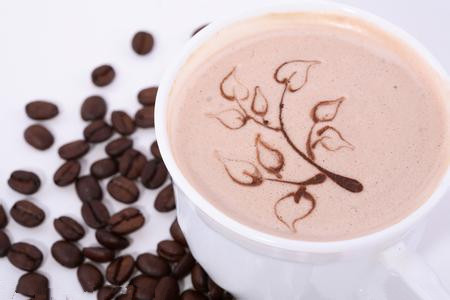Basic knowledge of boutique coffee about coffee beans
Coffee beans grow in tropical or subtropical agricultural gardens around the equator, called coffee belts, and travel to Japan with ships. When the brown coffee beans appear in front of your eyes, they have actually gone through a variety of different circulation processes and the hands of many people.

Coffee is widely distributed in South America, Central America, the West Indies, Asia, Africa, Arabia, the South Pacific and Oceania. In terms of output, Brazil ranks first in the world's output (about 30%), followed by Central and South America with Colombia (about 10%) as the center, accounting for 60%, followed by Africa and Arabia accounting for about 30%. The remaining 10% are distributed in Asian countries and most islands.
Small and round dark brown coffee beans, quietly emitting a fragrant fragrance in the grinder, injected into the cup showing the beautiful color of amber, these are the three very deep impressions of coffee.
As you explore the history and beauty of coffee, you can also see the coffee trees that are caressed by the tropical sun and whose leaves twinkle. It has a small white flower similar to jasmine, its fruit from green to yellow-green, and finally to red, coffee beans are the seeds in its fruit.
Moreover, if you go to the coffee bean refinery, you will surely see the red pulp called coffee cherry and the fresh and green coffee raw beans with the endocarp and silver skin removed. These are the coffee beans for export.
At present, there are about 60 coffee-producing countries, most of which are located in areas with elevations of 300,400m. Sometimes coffee trees are cultivated on highlands with elevations of 2000-2500 meters, but those planted on slopes above 1500 meters above sea level are said to be of better quality.
The most suitable conditions for the cultivation of coffee trees are areas where the annual rainfall is 1500-2000 mm and the average temperature is about 20 degrees.
Coffee trees are evergreen plants of the Akanaceae family. If they are wild, they can even grow to more than eight meters. However, in the farm, the height is cut to about two meters to ensure the quality of coffee beans and facilitate management.
At present, the main tree species planted are Arabica species, Robusta species (Carneva species) and Liberika species. It can be subdivided into dozens of varieties, which will be distinguished in production, circulation and trading.
Even in the same producing country, it will have a subtle influence on the flavor and quality of coffee beans and produce their own characteristics because of the differences in climate, altitude and soil quality in different regions. Therefore, according to the variety, origin, there will be different attributes: therefore, it is impossible to describe the characteristics of a country's coffee beans in one sentence!
● from coffee cherries to raw coffee beans
About raw coffee beans
A coffee tree can bear about 3-5 kilograms of coffee cherries and can be refined into 1/5 weight raw coffee beans. Among them, through the hands and time of many people, coffee cherries are transformed into raw coffee beans.
Arabica species and Robusta species
Arabica accounts for about 2/3 of the world's coffee production, so it is not suitable to grow in areas with high temperature, low temperature, more rain and less rain. The beans are oval shoulder flat, characterized by strong fragrance and good quality.
Robusta is bitter but not sour, and the flavor is not very good, so it is suitable for making mixed-flavor coffee. Mixed with the right amount of robusta in Arabica, it is usually used to make iced coffee, instant coffee and canned coffee. It is characterized by growing in lowlands. Strong disease resistance.
The quality and output of Liberika are not good. Most of them are exported to Europe, but not imported to Japan.
Flat beans and round beans
Ripe and red coffee cherries have multiple structures. In the middle is the predecessor of the coffee bean, the light green seed. Generally speaking, the fruit of coffee is made up of two oval seeds opposite each other. The side that connects with each other is a flat joint, so it is called flat bean. But some are made up of a round seed, and its taste is no different.
From harvest to shipment
After the fruit is harvested, the outer skin, pulp, endocarp and silver skin should be removed before shipping. There are two kinds of methods: drying (also known as natural or non-washing) and washing.
The drying method is relatively simple. First of all, spread the freshly harvested fruit on the exposure field for a week or two until the fruit crackles and dries naturally. After that, the dried pulp, endocarp and silver peel are removed by a sheller.
Coffee beans refined in this way are slightly sour and slightly bitter. Almost all coffee beans produced in Brazil, Ethiopia, Yemen and other places are obtained in this way. The disadvantage of this method is that it is easily affected by weather and is easy to be mixed with defective beans and other impurities. Therefore, teachers must be carefully selected.
Another way is to wash the fruit, in which the fruit to be harvested is put into a flowing trough. After the floating fruit is removed, the skin and flesh are removed by a pulp remover. Then put it in the sink to remove the emerging pulp. After that, move into the fermentation tank, soak for half a day to a day, and then dissolve the gum on the surface of the fermented coffee beans. After washing with water, drying it for a few days, drying it with a machine, and finally using a sheller to remove the endocarp to become a commercial raw coffee bean.
Water-washed coffee beans are more beautiful in color and less impurity than those obtained by drying. Colombia, Mexico, Guatamara and other countries adopt this method for about 70% of their output.
Sometimes in the fermentation process, if not handled properly, it may give off fermentation odor and its unique sour taste, but if handled properly, all kinds of beans can give off their unique coffee aroma.
In order to be delivered completely to the destination, raw coffee beans are packed in sacks and placed in special containers for long-distance merchant shipping trips.
Important Notice :
前街咖啡 FrontStreet Coffee has moved to new addredd:
FrontStreet Coffee Address: 315,Donghua East Road,GuangZhou
Tel:020 38364473
- Prev

Steps for making coffee and brewing coffee in Turkey
Old-fashioned traditional coffee from Turkey. It is said that there is a habit of coffee fortune-telling in Turkey. After drinking coffee, the coffee grounds deposited at the bottom of the cup are covered on a plate to predict the fate of the day according to what it looks like. Practice: put the deep-roasted coffee beans in a milk bowl and grind them into a very fine powder and grind them together with cinnamon and other spices. And then put these in the pot.
- Next

The main origin of coffee introduces the selection system of coffee beans.
At present, due to the wide variety of imported coffee beans on the market all over the world, there is no choice. Here, we will introduce the main producing areas and the characteristics of coffee beans as a reference for you to buy coffee. * Brazil (South America) is the world's number one coffee producer and exporter. Because it is distributed all over the country, the quality is different, and it has its own standard (NO.2 according to the amount of dopants)
Related
- Beginners will see the "Coffee pull flower" guide!
- What is the difference between ice blog purified milk and ordinary milk coffee?
- Why is the Philippines the largest producer of crops in Liberia?
- For coffee extraction, should the fine powder be retained?
- How does extracted espresso fill pressed powder? How much strength does it take to press the powder?
- How to make jasmine cold extract coffee? Is the jasmine + latte good?
- Will this little toy really make the coffee taste better? How does Lily Drip affect coffee extraction?
- Will the action of slapping the filter cup also affect coffee extraction?
- What's the difference between powder-to-water ratio and powder-to-liquid ratio?
- What is the Ethiopian local species? What does it have to do with Heirloom native species?

